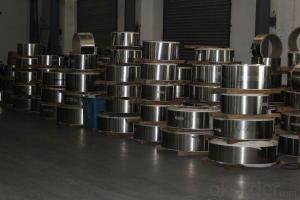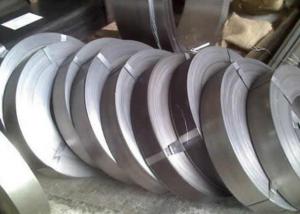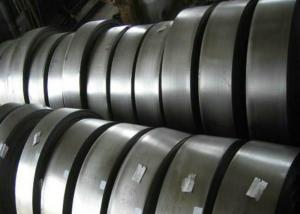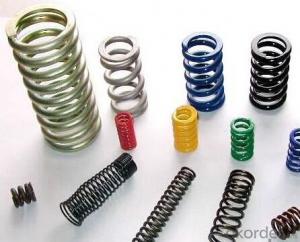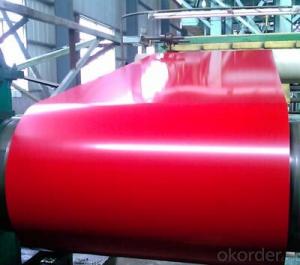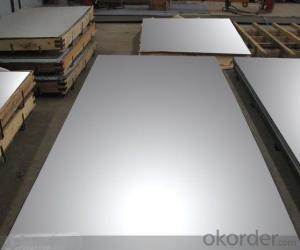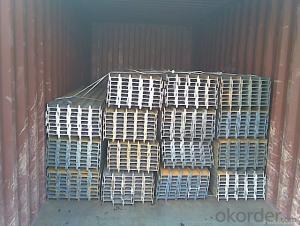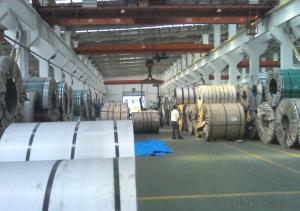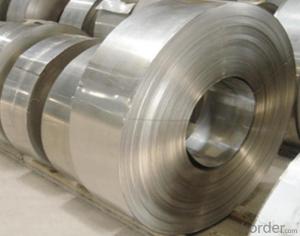Stainless Steel Strip
- Loading Port:
- China Main Port
- Payment Terms:
- TT OR LC
- Min Order Qty:
- -
- Supply Capability:
- -
OKorder Service Pledge
OKorder Financial Service
You Might Also Like
Specifications
Standard:ASTM A554
Thickness: 0.2mm - 2.5
Surface: BA / 2B / satin
width:25-500mm
package:wooden case
Name: Stainless Steel Tube welded
2.Standard: JIS, GB, DIN, ASTM, EN, AISI
3.Materials: AISI 201, 202, 301, 304, 304L, 316, 430, etc.
4.Size: a) Width: 25-500MM
b)Thickness: 0.2-5.0mm,
Other specifications are welcome from your request.
5.Finishing: annealed, pickled, polished inside and outside
grit: 2B(Mill Finish), 2D, 180#, 320#, 400#, 600#, HL, Mirror, satin, bright,etc.
6.Packaging: woodden case
7.Application: widely used in sewerage disposal, decoration,food, beverage, milk, refine sugar, medicine, etc.
8.Best products+best price+best servive
- Q: How are steel strips measured for thickness?
- Steel strips are typically measured for thickness using specialized tools such as micrometers or thickness gauges. These instruments allow for accurate and precise measurements by exerting a controlled pressure on the strip and providing a digital or analog readout of its thickness.
- Q: How are steel strips tested for coating adhesion?
- Steel strips are tested for coating adhesion using various methods to ensure the quality and durability of the protective coating. One common method is the cross-cut adhesion test. In this test, a sharp blade or knife is used to create a series of parallel cuts through the coating, forming a grid pattern. The cuts are then made at a 90-degree angle to create a checkerboard pattern. After the cuts are made, a pressure-sensitive adhesive tape is applied firmly over the grid pattern and then quickly removed. The adhesion of the coating is evaluated based on the amount of coating that remains on the steel surface after the tape is removed. If the coating remains intact without significant peeling or detachment, it indicates good adhesion. Another method used for testing coating adhesion on steel strips is the pull-off test. In this test, a specialized instrument called a pull-off adhesion tester is used. A small circular metal disc is bonded to the surface of the coated steel strip using a specific adhesive. Once the adhesive has cured, a pulling force is applied to the disc using the tester. The force required to detach the disc from the surface is measured and used as an indicator of coating adhesion. Higher force requirements indicate better adhesion. Additionally, the bend test is often conducted to evaluate the adhesion of the coating on steel strips. In this test, the coated steel strip is bent to a specific angle, typically 180 degrees, around a cylindrical mandrel of a predetermined diameter. The coating's ability to withstand the bending without cracking or peeling off is assessed. If the coating remains intact and adhered to the steel surface, it indicates good adhesion. Overall, these testing methods help ensure that steel strips have a strong and durable coating adhesion, which is crucial for their performance in various applications, such as corrosion protection and aesthetic appearance.
- Q: Can steel strips be used in the production of kitchen utensils?
- Kitchen utensils can indeed be produced using steel strips. The strength, durability, and corrosion resistance of steel make it a popular choice for such utensils. It is common to use steel strips as the raw material for manufacturing different utensils, including knives, spoons, forks, spatulas, and tongs. These strips can be shaped, formed, and forged into the desired sizes and shapes of utensils. Furthermore, steel strips provide a smooth and hygienic surface, which is ideal for handling and cooking food. Moreover, steel utensils are easy to clean and maintain, which is why they are preferred in many kitchens.
- Q: How are steel strips processed for improved surface finish?
- Steel strips can be processed in various ways to achieve an improved surface finish. One common method is through the process of pickling and oiling. Pickling involves the immersion of steel strips in an acidic bath, such as hydrochloric acid, to remove any scales or impurities on the surface. This helps to create a clean and smooth surface. After pickling, the strips are rinsed and then coated with oil to prevent oxidation and improve the appearance of the surface. Another method used for improving the surface finish of steel strips is cold rolling. This involves passing the strips through a series of rollers at room temperature, which not only reduces the thickness but also enhances the surface finish. Cold rolling helps to create a more uniform and smooth surface, minimizing any imperfections or roughness. Furthermore, steel strips can undergo annealing to improve the surface finish. Annealing is a heat treatment process that involves heating the steel strips to a specific temperature and then slowly cooling them. This process helps to relieve internal stresses and improve the crystal structure of the steel, resulting in a refined and smoother surface. Additionally, steel strips can be subjected to various mechanical treatments, such as grinding or polishing, to further enhance the surface finish. Grinding involves the use of abrasive wheels or belts to remove any imperfections or roughness on the surface. Polishing, on the other hand, utilizes a fine abrasive material to create a smooth and shiny surface. In summary, steel strips can be processed for improved surface finish through methods such as pickling and oiling, cold rolling, annealing, and mechanical treatments like grinding and polishing. These processes help to remove impurities, reduce roughness, and create a clean and smooth surface, resulting in an enhanced appearance and performance of the steel strips.
- Q: How do steel strips perform in terms of electrical resistance?
- Steel strips have relatively high electrical resistance compared to other metals such as copper or aluminum. This means that they are not as efficient in conducting electricity and can cause higher energy losses.
- Q: What are the common surface treatments for steel strips?
- Common surface treatments for steel strips include hot-dip galvanizing, electroplating, powder coating, and painting.
- Q: Can steel strips be used in the production of hydraulic systems?
- Yes, steel strips can be used in the production of hydraulic systems. Steel strips are commonly used for manufacturing various components such as tubing, fittings, and brackets that are integral to hydraulic systems. Steel's high strength, durability, and resistance to corrosion make it a suitable material for hydraulic applications.
- Q: How are steel strips used in the production of consumer electronics?
- Steel strips have various applications in the production of consumer electronics. Firstly, they are commonly used as components for manufacturing electronic device casings or housings. By shaping and sizing the strips, they create a sturdy structure that protects the internal components. Moreover, steel strips are utilized in the production of brackets, frames, and other structural components within consumer electronics. These strips are cut, shaped, and welded to create supports and reinforcements that secure and stabilize different parts of the electronic device. In addition, steel strips are employed in the production of connectors and electrical contacts. They are precisely cut and treated to ensure proper conductivity and durability. These strips establish electrical connections within the device, enabling the flow of current between components. In summary, steel strips are essential in the production of consumer electronics as they provide strength, durability, and functionality to the final product. Their versatility and ability to be formed into various shapes make them valuable in the manufacturing process, ensuring the reliability and longevity of electronic devices.
- Q: What are the common maintenance practices for steel strips?
- Common maintenance practices for steel strips include regular cleaning, lubrication, and inspection. Cleaning is an important maintenance practice for steel strips as it helps to remove dirt, debris, and other contaminants that can accumulate on the surface. This can be done using a mild detergent or a specialized cleaner that is designed for steel surfaces. It is important to avoid using abrasive cleaners or tools that can scratch or damage the steel. Lubrication is another critical maintenance practice for steel strips, especially if they are used in moving parts or machinery. Applying a suitable lubricant helps to reduce friction and wear, ensuring smooth operation and extending the lifespan of the steel strips. The type of lubricant used will depend on the specific application and the requirements of the equipment. Regular inspection is essential to identify any signs of damage or wear on the steel strips. This can include checking for cracks, dents, or any other abnormalities that may affect their performance or structural integrity. Any issues should be addressed promptly to prevent further damage and potential safety hazards. Additionally, it is important to store steel strips properly to prevent rust or corrosion. This can be achieved by keeping them in a dry and well-ventilated area, away from moisture or chemicals that can cause damage. Applying a protective coating or using rust inhibitors can also help to prevent corrosion. Overall, by following these common maintenance practices, steel strips can be kept in good condition, ensuring their optimal performance and longevity.
- Q: What are the different protective coatings available for steel strips?
- There are several protective coatings available for steel strips, including galvanized coatings, zinc coatings, epoxy coatings, polyurethane coatings, and powder coatings. These coatings help to prevent corrosion and extend the lifespan of the steel strips in various environments and applications.
Send your message to us
Stainless Steel Strip
- Loading Port:
- China Main Port
- Payment Terms:
- TT OR LC
- Min Order Qty:
- -
- Supply Capability:
- -
OKorder Service Pledge
OKorder Financial Service
Similar products
Hot products
Hot Searches
Related keywords
